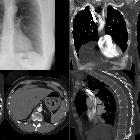pericardial fat pads

Pericardial
fat pads • Pericardial fat pads - Ganzer Fall bei Radiopaedia

Pericardial
fat pads • Epicardial fat pad - Ganzer Fall bei Radiopaedia

Pericardial
fat pads • Pericardial fat - Ganzer Fall bei Radiopaedia

Pericardial
fat pads • Pericardial fat pad - Ganzer Fall bei Radiopaedia
Pericardial fat pads are normal structures that lie in the cardiophrenic angle. They are adipose tissues surrounding the heart composed of the epicardial fat, which lies between the myocardium and visceral pericardium, and paracardial fat, which is adherent and external to the parietal pericardium. Unsurprisingly, they are more prominent in obese patients.
Pathology
They can be affected by fat necrosis, see: pericardial fat necrosis.
Radiographic features
Plain radiograph
- mass or hazy opacity in the cardiophrenic angle
- cardiac and diaphragmatic silhouettes usually visible
CT
- easily differentiates pericardial fat pad from pathology other than a lipoma
Differential diagnosis
At times they are large enough to simulate pathology and can be mistaken for:
- lipoma or another pericardial tumor
- pericardial cyst (especially on the right)
- Morgagni hernia
- epicardial lymphadenopathy
- pleural tumor
- pseudocardiomegaly
Siehe auch:
- pleuroperikardiale Schwielen
- Morgagni-Hernie
- Läsionen im kardiophrenischen Winkel
- Epipericardial fat necrosis
und weiter:

 Assoziationen und Differentialdiagnosen zu parakardiales Fettbürzel:
Assoziationen und Differentialdiagnosen zu parakardiales Fettbürzel:Läsionen im
kardiophrenischen Winkel


